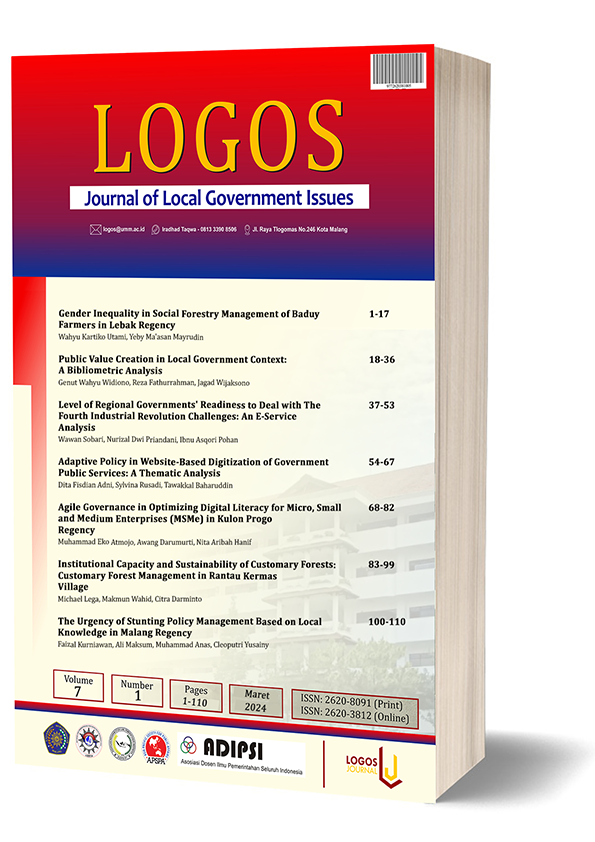The Urgency of Stunting Policy Management Based on Local Knowledge in Malang Regency
DOI:
https://doi.org/10.22219/logos.v7i1.25669Keywords:
local knowledge, prevention, stunting policy managementAbstract
In the Malang Regency region, the issue of stunting is pressing. According to statistics showing the high rate of stunting in Malang Regency, a stunting management strategy must be put into place right away. To date, the issue has been whether policies at the upstream level address all the factors necessary to combat stunting. This study talks about how urgent municipal policies are, particularly for managing stunting. It should be mentioned that government policies currently in place are focused on improving and regulating food security, food quality, and program socialization. Additionally, both targeted and delicate treatments are a manifestation of the prevention of stunting. The heath industry performs specific interventions. The phenomenology of Malang Regency's stunting prevention strategies is revealed by this study. According to the study's findings, there are a number of issues that require immediate attention, particularly those that are local in nature, like local education on the marriage readiness index, particularly in areas with a high incidence of young marriage, like Tajinan sub-district. The health sector, as well as other connected sectors, must be involved in the regional follow-up to the village level of policies and regulations that are in place at the federal level. Due to the community's increased knowledge of the value of a balanced diet and the readiness of parents at marriageable age, the community-based coping system needs to be improved once more. Localized coping strategies will undoubtedly.
Downloads
References
Adriany, V., & Newberry, J. (2022). Neuroscience and the construction of a new child in early childhood education in Indonesia: A neoliberal legacy. Current Sociology, 70(4), 539–556. https://doi.org/10.1177/0011392120985875
Aguayo, V. M., & Menon, P. (2016). Stop stunting: improving child feeding, women’s nutrition and household sanitation in South Asia. Maternal & child nutrition, 12, 3–11). Wiley Online Library. https://doi.org/10.1111/mcn.12283
Alfani, F., Dabalen, A., Fisker, P., & Molini, V. (2019). Vulnerability to stunting in the West African Sahel. Food Policy, 83, 39–47. https://doi.org/10.1016/j.foodpol.2018.11.002
Anderson, E. N., & Anderson, B. A. (2023). A Method in Our Madness: Experiences With Seeking Local Knowledge. Journal of Ethnobiology, 43(1), 6–11. https://doi.org/10.1177/02780771231162183
Astuti, Y., Paek, S. C., Meemon, N., & Marohabutr, T. (2024). Analysis of traditional feeding practices and stunting among children aged 6 to 59 months in Karanganyar District, Central Java Province, Indonesia. BMC Pediatrics, 24(1), 1–18. https://doi.org/10.1186/s12887-023-04486-0
Atamou, L., Rahmadiyah, D. C., Hassan, H., & Setiawan, A. (2023). Analysis of the Determinants of Stunting among Children Aged below Five Years in Stunting Locus Villages in Indonesia. Healthcare (Switzerland), 11(6), 1–12. https://doi.org/10.3390/healthcare11060810
Beal, T., Tumilowicz, A., Sutrisna, A., Izwardy, D., & Neufeld, L. M. (2018). A review of child stunting determinants in Indonesia. Maternal and Child Nutrition, 14(4), 1–10. https://doi.org/10.1111/mcn.12617
Cameron, L., Chase, C., Haque, S., Joseph, G., Pinto, R., & Wang, Q. (2021). Childhood stunting and cognitive effects of water and sanitation in Indonesia. Economics & Human Biology, 40, 100944. https://doi.org/10.1016/j.ehb.2020.100944
Chapman, A. J., Ebido, C. C., Tening, R. N., Huang, Y., & Sougou, N. M. (2024). Creating culturally ‑ informed protocols for a stunting intervention using a situated values ‑ based approach ( WeValue InSitu ): a double case study in Indonesia and Senegal. BMC Public Health, 1–18. https://doi.org/10.1186/s12889-024-18485-y
Cheshmehzangi, A., You, N., Siri, J., & Birch, E. (2024). The Role of Public Health Services Through OMABA Cooking Center for Managing Malnourished and Stunting Children in Bandung, Indonesia BT - Harnessing Urban Innovation to Unlock the Sustainable Development Goals (A. Cheshmehzangi, N. You, J. Siri, & E. Birch (eds.); pp. 73–77). Springer Nature Singapore. https://doi.org/10.1007/978-981-99-9971-2_8
Daniel, D., Qaimamunazzala, H., Prawira, J., Siantoro, A., Sirait, M., Tanaboleng, Y. B., & Padmawati, R. S. (2023). Interactions of Factors Related to the Stunting Reduction Program in Indonesia: A Case Study in Ende District. International Journal of Social Determinants of Health and Health Services, 53(3), 354–362. https://doi.org/10.1177/27551938231156024
Himaz, R. (2018). Stunting later in childhood and outcomes as a young adult: Evidence from India. World Development, 104, 344–357. https://doi.org/10.1016/j.worlddev.2017.12.019
Katmawanti, S., Supriyadi, & Mariroh, F. (2021). Is instant porridge with a high calcium content based on Moringa oleifera as an alternative baby food to prevent Stunting in Indonesia? Journal of Public Health Research, 10(2), 353–357. https://doi.org/10.4081/jphr.2021.2233
Krishna, A., Mejía-Guevara, I., McGovern, M., Aguayo, V. M., & Subramanian, S. V. (2018). Trends in inequalities in child stunting in South Asia. Maternal and Child Nutrition, 14, 1–12. https://doi.org/10.1111/mcn.12517
Krosby, S. S., Rahmi, S. A., & Mintasrihardi. (2024). Implementation of Integrated Stunting Prevention Acceleration Policy in Mataram City, 10(1), 30–43. https://doi.org/10.32666/tatasejuta.v10i1.618
Latifa, S. N. (2018). Kebijakan Penanggulangan Stunting di Indonesia. Jurnal Kebijakan Pembangunan, 13(2), 173–179. Retrieved from https://jkpjournal.com/index.php/menu/article/view/78
M’Kaibi, F. K., Steyn, N. P., Ochola, S. A., & Du Plessis, L. (2017). The relationship between agricultural biodiversity, dietary diversity, household food security, and stunting of children in rural Kenya. Food Science and Nutrition, 5(2), 243–254. https://doi.org/10.1002/fsn3.387
Maharanii, R. A., Utoyo, B., & Sulistio, E. B. (2020). Manajemen Aset Pemerintah Daerah. Administrativa, 2(3), 45–54. http://dx.doi.org/10.23960/administrativa.v2i3.52
Mascarini, S., Garcia, R., & Quatraro, F. (2023). Local knowledge spillovers and the effects of related and unrelated variety on the novelty of innovation. Regional Studies, 57(9), 1666–1680. https://doi.org/10.1080/00343404.2022.2147917
Maulana, I. N. H., Sholihah, Q., & Wike, W. (2022). Implementasi Kebijakan Intervensi Gizi Spesifik sebagai Upaya Penanganan Stunting di Kabupaten Malang. Jurnal Ilmiah Administrasi Publik, 8(2), 136–144. https://doi.org/10.21776/ub.jiap.2022.008.02.1
Maulidiana, A. R., & Sutjiati, E. (2021). Low intake of essential amino acids and other risk factors of stunting among under-five children in Malang City, East Java, Indonesia. Journal of Public Health Research, 10(2), 220–226. https://doi.org/10.4081/jphr.2021.2161
Mbah, M. (2019). Can local knowledge make the difference? Rethinking universities’ community engagement and prospect for sustainable community development. The Journal of Environmental Education, 50(1), 11–22. https://doi.org/10.1080/00958964.2018.1462136
Mediani, H. S., Hendrawati, S., Pahria, T., Mediawati, A. S., & Suryani, M. (2022). Factors Affecting the Knowledge and Motivation of Health Cadres in Stunting Prevention Among Children in Indonesia. Journal of Multidisciplinary Healthcare, 15, 1069–1082. https://doi.org/10.2147/JMDH.S356736
Mendes-Lima, T., Kirsten, T. B., Rodrigues, P. S., Sampaio, A. C. S., Felício, L. F., Rocha, P. R. D. A., Reis-Silva, T. M., Bondan, E. F., Martins, M. F. M., Queiroz-Hazarbassanov, N., & Bernardi, M. M. (2020). Prenatal LPS induces sickness behaviour and decreases maternal and predatory behaviours after an LPS challenge. International Journal of Neuroscience, 130(8), 804–816. https://doi.org/10.1080/00207454.2019.1706505
Miranda, A. V., Sirmareza, T., Nugraha, R. R., Rastuti, M., Syahidi, H., Asmara, R., & Petersen, Z. (2023). Towards stunting eradication in Indonesia: Time to invest in community health workers. Public Health Challenges, 2(3), 1–6. https://doi.org/10.1002/puh2.108
Montenegro, C. R., Gomez, G., Hincapie, O., Dvoretskiy, S., DeWitt, T., Gracia, D., & Misas, J. D. (2022). The pediatric global burden of Stunting: Focus on Latin America. Lifestyle Medicine, 3(3), 1–11. https://doi.org/10.1002/lim2.67
Muchlis, N., Yusuf, R. A., Rusydi, A. R., Mahmud, N. U., Hikmah, N., Qanitha, A., & Ahsan, A. (2023). Cigarette Smoke Exposure and Stunting Among Under-five Children in Rural and Poor Families in Indonesia. Environmental Health Insights, 17(December 2022). https://doi.org/10.1177/11786302231185210
Nuñez, P. A., Fernández, M. S., Turjanski, P., Pérez, A., Rivero, M. R., De Angelo, C., Salomón, O. D., & Cueto, G. (2020). Substantial reduction in child stunting is differentially associated to geographical and socioeconomic disparities in Misiones Province, Argentina. Tropical Medicine and International Health, 25(7), 874–885. https://doi.org/10.1111/tmi.13400
Permatasari, T. A. E., Chadirin, Y., Ernirita, Elvira, F., & Putri, B. A. (2023). The association of sociodemographic, nutrition, and sanitation on stunting in children under five in rural area of West Java Province in Indonesia. Journal of Public Health Research, 12(3). https://doi.org/10.1177/22799036231197169
Pukkalla, D., & Rama Mohan, K. R. (2020). Local Knowledge and Marine Livelihoods Among the South Indian Fishing Community. Journal of Asian and African Studies, 56(3), 549–557. https://doi.org/10.1177/0021909620931524
Rahayuwati, L., Komariah, M., Sari, C. W. M., Yani, D. I., Hermayanti, Y., Setiawan, A., Hastuti, H., Maulana, S., & Kohar, K. (2023). The Influence of Mother’s Employment, Family Income, and Expenditure on Stunting Among Children Under Five: A Cross-Sectional Study in Indonesia. Journal of Multidisciplinary Healthcare, 16, 2271–2278. https://doi.org/10.2147/JMDH.S417749
Ritzer, Geoge. (2009). Sociological Theory. London: McGraw Hill Companies
Rizal, M. F., & van Doorslaer, E. (2019). Explaining the fall of socioeconomic inequality in childhood stunting in Indonesia. SSM - Population Health, 9, 100469. https://doi.org/10.1016/j.ssmph.2019.100469
Rukiko, M. D., Mwakalobo, A. B. S., & Mmasa, J. J. (2023). The impact of Conditional Cash Transfer program on stunting in under five year’s poor children. Public Health in Practice, 6, 100437. https://doi.org/10.1016/j.puhip.2023.100437
Sahroji, Q. N., Hidayat, R., & Nababan, R. (2022). Implementasi Kebijakan Dinas Kesehatan Dalam Penanganan Stunting Di Kabupaten Karawang. Jurnal Pemerintahan Dan Politik, 7(1), 34–39. https://doi.org/10.36982/jpg.v7i1.1983
Saleh, A., Syahrul, S., Hadju, V., Andriani, I., & Restika, I. (2021). Role of Maternal in Preventing Stunting: a Systematic Review. Gaceta Sanitaria, 35, S576–S582. https://doi.org/10.1016/j.gaceta.2021.10.087
Saputri, R. A., & Tumangger, J. (2019). Hulu-Hilir Penanggulangan Stunting Di Indonesia (Upstream and Downstream Stunting Prevention in Indonesia). Journal of Political Issues, 1(1), 1–9. https://doi.org/10.33019/jpi.v1i1.2
Suciyanti, D., Wangge, G., Fahmida, U., & Supali, T. (2021). Stunting Among Children in Rural Area of Indonesia: Five-Year Follow-Up Study. Current Developments in Nutrition, 5, 187-200. https://doi.org/10.1093/cdn/nzab035_095
Sujai, M. (2020). PERANAN KEBIJAKAN FISKAL DALAM MENINGKATKAN PROGRAM PENGURANGAN STUNTING DI INDONESIA: STUDI KASUS KOTA BALIKPAPAN. Journal of Humanity and Social Justice, 2(2), 99–112.
Supadmi, S., Laksono, A. D., Kusumawardani, H. D., Ashar, H., Nursafingi, A., Kusrini, I., & Musoddaq, M. A. (2024). Factor related to stunting of children under two years with working mothers in Indonesia. Clinical Epidemiology and Global Health, 26(February), 101538. https://doi.org/10.1016/j.cegh.2024.101538
Tanaka, J., Yoshizawa, K., Hirayama, K., Karama, M., Wanjihia, V., Changoma, M. S., & Kaneko, S. (2019). Relationship between dietary patterns and stunting in preschool children: a cohort analysis from Kwale, Kenya. Public Health, 173, 58–68. https://doi.org/10.1016/j.puhe.2019.05.013
Downloads
Published
How to Cite
Issue
Section
License
Copyright (c) 2024 Faizal Kurniawan, Ali Maksum, Muhammad Anas, Cleoputri Yusainy

This work is licensed under a Creative Commons Attribution-ShareAlike 4.0 International License.
Authors who publish with this journal agree to the following terms:
- Authors retain copyright and grant the journal right of first publication with the work simultaneously licensed under a Creative Commons Attribution-ShareAlike 4.0 International License. that allows others to share the work with an acknowledgment of the work's authorship and initial publication in this journal.
- Authors are able to enter into separate, additional contractual arrangements for the non-exclusive distribution of the journal's published version of the work (e.g., post it to an institutional repository or publish it in a book), with an acknowledgment of its initial publication in this journal.
- Authors are permitted and encouraged to post their work online (e.g., in institutional repositories or on their website) prior to and during the submission process, as it can lead to productive exchanges, as well as earlier and greater citation of published work (See The Effect of Open Access).

This work is licensed under a Creative Commons Attribution-ShareAlike 4.0 International License.













